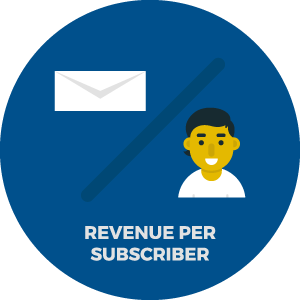Increase email revenue by determining your ideal revenue per subscriber, and then using service journalism to keep them on a path toward monetization

A Mequoda online publishing and marketing system measures revenue produced by email newsletter subscribers differently from the way that print publishers have traditionally measured the lifetime value of a subscriber.
The revenue per email subscriber is determined by taking the total email revenue and dividing it by the average number of email subscribers on an email marketing list. An increase in email revenue leads to a substantial increase in overall business revenue. If you focused solely on increasing the amount of revenue per subscriber, you could even turn a spiraling business around.
Based on all the Mequoda Systems we have built, the average email newsletter has about 100,000 active email newsletter subscribers who are all potential paying customers. The email newsletter subscribers pay nothing for their newsletters directly but monetize themselves by buying all manner of products and services that are sponsored in the email newsletters they receive.
[text_ad]
If you can average $50 in revenue per 1,000 emails sent to your email newsletter subscribers, and your contact frequency is daily (five emails per week), you’ll generate an average of five cents per subscriber every time you mail. At five times a week, that amounts to 25 cents per week or about $13 per year for every email newsletter subscriber.
So, if your average value per subscriber is $13, and you have 100,000 subscribers, your email marketing system is grossing $1.3 million annually.

Several factors can affect this measurement. For example, did you send the right number of emails? Is your email list hygiene adequate? What offers did you make for subscription products on the web site? What was the product mix you offered in the email promotions?
Every month, you should review these factors with your team (we also keep track of these numbers and review with our Gold Members). We’ll discuss what’s working and what can be improved, and help you develop and maintain a plan to keep the revenue flowing and growing.
How to increase email revenue through service journalism

One piece of advice I’ll never forget came from the HR Daily Advisor‘s Jay Schleifer. This is a man who was the former Director of Marketing at Business & Legal Resources, who they pulled back from retirement to lead their new HR portal, which needed someone who could tactfully sell products through email.
Jay’s approach to, what turned out to be a highly successful portal that took off enough so that he could retire for the second time, was something he called service journalism.
“When you read a movie review in a newspaper or a product review in Popular Mechanics, you’re reading an advertisement. But the audience doesn’t see it as that; they see it as you doing them a service to help make up their mind on what electronic device they should buy. If you can write it up in a way that makes them feel like you’re doing them a service, they won’t see it as advertising.”
Schleifer believes that the process is always the same; as a writer you are looking for a “key.” The key is how to make a subtle yet effective sale via journalism. No one subscribes to an email newsletter to be sold a product day after day, the same way people don’t sign up their home address for Publisher’s Clearing House. Therefore, you must continuously deliver value while still profiting from your online business and email marketing program.
Your email newsletter should give enough away to be useful to your email subscribers, but it should not lack calls to action. Keep it mind that free email subscribers may take several newsletters before they become paid magazine subscribers, or buyers of other paid products. At Mequoda, we employ an email stack design that squeezes in text ads for related products in between featured articles, like a club sandwich.
Think of your email newsletter as a little more than an “amuse bouche” – a small bite at a restaurant that offers a glimpse into the chef’s personality and approach to cooking. Your content should offer completeness in its enjoyment, but should lead to the next dish, not a final course that makes you too full to keep on dining.


